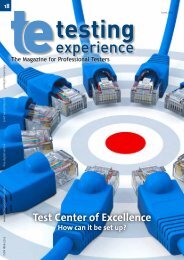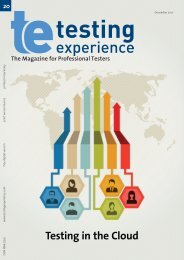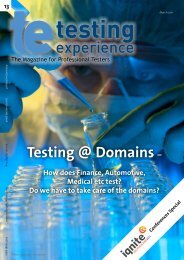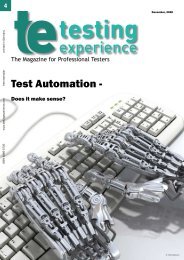Agile Performance Testing - Testing Experience
Agile Performance Testing - Testing Experience
Agile Performance Testing - Testing Experience
Create successful ePaper yourself
Turn your PDF publications into a flip-book with our unique Google optimized e-Paper software.
tially desired test script shown in the picture below.<br />
Figure 6 – Final Test Script<br />
4. Final Considerations<br />
During the development of our work, several constraints could<br />
be observed that could affect the full utilization of our approach.<br />
We could also point out several enhancements and studying opportunities<br />
for developing the described approach further and<br />
make it a real alternative to all existing performance testing techniques.<br />
These are some of the constraints and opportunities identified:<br />
• Limited feature model representation possibilities. During<br />
domain analysis performed to support the creation of derivation<br />
models, some details needed to be left out in order to<br />
facilitate an easier and faster understanding of the tool to<br />
create new performance test script instances. On the other<br />
hand, some features like simulating user abandonment for<br />
load tests, multiple threads or multiple virtual users groups,<br />
among others, could not be modelled in a way that would<br />
produce a correct derivation, restricting its use to the manual<br />
customization task performed in the last step of our approach.<br />
Future enhancements on our work may successfully<br />
model these features.<br />
www.testingexperience.com<br />
Biography<br />
• Reuse between applications and test type. During the development<br />
of our research, we detected that the reuse of test<br />
scripts may occur among different types of performance<br />
tests and also among different applications. Regarding performance<br />
test types, our work concluded that different performance,<br />
load or stress test scripts vary mostly with regard<br />
to configuration parameters, but generally present a similar<br />
structure. Besides that, we observed that the test scripts of<br />
different applications share several common elements, allowing<br />
a greater reutilization of element definitions.<br />
• Approach usage with other non-functional test types. We<br />
also identified that the defined approach could also be used<br />
for deriving test scripts for other non-functional requirements,<br />
like security, reliability, etc. With regard to security,<br />
for example, it is possible to apply our approach, even including<br />
Jmeter, to simulate scenarios that involve resources exhaustion<br />
to identify possible security failures related to this<br />
condition.<br />
• Eliminating customizations and adaptations through approach<br />
restructuring. A research extension with the purpose<br />
of identifying alternatives is to look into possibilities to make<br />
it possible to eliminate the task of adapting the generated<br />
script for correct execution. This would contribute for the<br />
removal of the recording operation for transactions that are<br />
not included in the derivation tool, which would make the<br />
script generation a lot easier.<br />
• Automatic model derivation through test scripts. This is<br />
about defining a way of adapting the existing annotations<br />
feature, already used by GenArch, to enable an automatic<br />
model derivation from a group of test scripts. This could reduce<br />
the amount of work that currently needs to be done in<br />
script analysis and model creation, which in our research<br />
were done entirely manually.<br />
In our work we defined an approach for the derivation of performance<br />
test scripts for web applications, which is composed of six<br />
steps. This has the main goal of deriving new test script instances,<br />
but also has the objective to allow an easy way of adapting these<br />
test scripts to other test types and scenarios.<br />
In this article, the approach developed during a software engineering<br />
master course accomplished at C.E.S.A.R.(Recife Center for<br />
Advanced Studies and Systems) institute was described in some<br />
detail. For further information regarding the results achieved<br />
and/or any other questions, please contact one of the authors.<br />
José Carréra, MSc, has been test engineer at C.E.S.A.R. (Recife Center<br />
for Advanced Studies and Systems) since 2006 and Professor of<br />
Computer Science at the Faculdade de Tecnologia de Pernambuco,<br />
Brazil, since 2010. He holds a master degree in software engineering,<br />
graduated in computer science, and he is a Certified Tester — Foundation<br />
Level (CTFL), certified through the ISTQB (International Software<br />
<strong>Testing</strong> Qualifications Board). His research interests include<br />
performance testing, exploratory testing, agile methodologies and<br />
software quality in general.<br />
Uirá Kulesza is an Associate Professor at the Computer Science<br />
Department (DIMAp), Federal University of Rio Grande do Norte<br />
(UFRN), Brazil. He obtained his PhD in Computer Science at PUC-Rio -<br />
Brazil (2007), in cooperation with University of Waterloo and Lancaster University. His main research interests include: aspect-oriented<br />
development, software product lines, and design/implementation of model-driven generative tools. He has co-authored over 70<br />
referred papers in international conferences, journals and books. He worked as a research member of the AMPLE project (2007-2009)<br />
- Aspect-Oriented Model-Driven Product Line Engineering (www.ample-project.net).<br />
The Magazine for Professional Testers<br />
57









